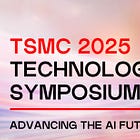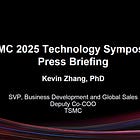2025 TSMC North America Technology Symposium_Topics Discussion_Part1
Original Articles by SemiVision Research (Dr. Kevin Zhang/Dr. Yuh-Jier Mii/Dr. Cliff Hou)
At the TSMC 2025 North America Technology Symposium, TSMC comprehensively introduced a range of critical advanced technology developments and provided in-depth insights into the key challenges and opportunities shaping the future of the semiconductor industry. In particular, senior technical executives — Dr. Kevin Zhang, Dr. Yuh-Jier Mii, and Dr. Cliff Hou — presented forward-looking perspectives on process technology, system integration, design platforms, and material innovations. SemiVision Research has prepared a dedicated and detailed interpretation of the event exclusively for our paid members, offering a thorough analysis of the technical highlights and strategic directions outlined by TSMC’s leadership for its future technology roadmap.
As AI technology rapidly permeates every sector, from cloud data centers to edge computing devices, intelligence is becoming ubiquitous. The AI revolution is expanding from centralized computing to edge environments, embedding itself into every endpoint device and driving the explosive growth of next-generation applications, including AI smartphones, AI PCs, AI-enabled AR/VR devices, humanoid robots, robo-taxis, and AIoT systems. This evolution is forming an expansive intelligent ecosystem with the AI data center at its core, radiating outward to empower a wide range of smart applications. Such a transformation imposes unprecedented challenges and demands on semiconductor technologies, making comprehensive advancements in advanced logic processes essential across the entire spectrum—from AI devices to cloud platforms. In the AI device domain, CPUs are being designed at 3nm and 4nm nodes, GPUs are moving into 5nm, and storage and Wi-Fi components are advancing toward 6nm and 7nm nodes. In edge computing, AI accelerators and storage controllers are primarily implemented in 6nm/7nm technologies, while networking chips predominantly remain at 7nm. For network infrastructure, critical components such as AAU (Active Antenna Unit), BBU (Baseband Unit), optical ASICs, controllers, and FPGAs are clustered around the 5nm to 7nm technology nodes. Meanwhile, cloud computing platforms are transitioning aggressively to 3nm and 4nm nodes, integrating 3nm/5nm AI accelerators and 5nm networking chips. Overall, from AI edge devices to cloud data centers, the entire AI computing chain is rapidly migrating toward next-generation, advanced semiconductor nodes, actively adopting new technologies to meet the growing demands for higher performance, lower power consumption, and greater integration density in future products.
For Paid Members , SemiVision will discuss topics on
TSMC Advanced Technology Roadmap
PPA of N2 ,A16 and A14 Technology node
Device architecture outlook
Innovation in CFET and 2D Materials
Innovation in HBM Base die
Innovation in Advanced Package










